Revolutionary War battlefields abound in New England, where, after all, the whole thing began. The patriots fought the British in every colony before and during the war, and many of the sites remain undeveloped.
Here is our choice for the best six Revolutionary War battlefields in New England, with one in each state.
Fort Griswold, Connecticut
Named after Deputy Gov. Matthew Griswold, the Connecticut Colony built the fort in 1775 in Groton to defend the supply depot at the mouth of the Thames River. The fort also protected privateers operating out of the harbor.
In 1781, the traitor Benedict Arnold led a company of British soldiers in an attack on New London. Meanwhile, another British commander, Edmund Eyre, attacked the fort. The British had the advantage. Arnold knew the angle to attack so the American gun positions couldn’t fire effective shots.
The British forces infamously massacred the American soldiers. After Col. William Ledyard surrendered his sword to the British, they ran him through with it. At the time of surrender, six Americans were dead and 20 wounded. When it was all over, 83 Americans were dead and 36 wounded. Arnold went on to burn New London.
The earthen walls of the fort still stand. The Ebenezer Avery House, which sheltered the wounded after the battle, has been restored on the grounds. A Revolutionary War museum also depicts the era.
For directions to Fort Griswold Battlefield State Park, click here. For information from the Friends of Fort Griswold Battlefield State Park, click here.
Fort George, Maine
Castine, located in Downeast Maine, is one of the oldest European communities in North America. Since the early 1600s, French, Dutch and English colonists have built trading posts, forts, missions and permanent settlements there.
In 1779, the British sent troops to occupy Castine with the hope of establishing a colony called New Ireland. They built a fort and named it after King George III.
Massachusetts, alarmed by the British occupation, sent a combined naval and military expedition to capture the fort that summer. Known as the Penobscot Expedition, it had 19 warships and 24 transports. Though the patriots outnumbered the British, they failed to take Fort George and suffered the worst U.S. naval defeat until Pearl Harbor. Paul Revere, in charge of ordnance, ended up court martialed for cowardice and insubordination. He fought the charges and won his acquittal.
Some of Fort George still remains, as does the British canal built in 1779, gravesites of Revolutionary War soldiers and historic houses, taverns and churches. Castine has marked its many historic sites with signs. (Click here for a map.)
Minute Man State Park, Massachusetts
It doesn’t get much better than Minute Man National Historic Park in Lexington, Lincoln and Concord.
The 970-acre park memorializes the opening battles of the American Revolution – and then some.
Lexington Battle Green, site of the shot heard round the world, belongs to the Town of Lexington. The Buckman Tavern sits on the green, which leads to the five-mile-long Battle Road Trail. Patriot militia skirmished with the British regulars along the trail, now a restored colonial landscape that includes the Hartwell Tavern.
In Concord, Daniel Chester French’s famous Minute Man statue stands by the North Bridge, where the colonial militia shot back at British soldiers in the second battle of the day.
The Wayside also belongs to the park. Authors Amos Bronson Alcott and his daughter Louisa May Alcott, Nathaniel Hawthorne, and Margaret Sidney lived there (not all at the same time).
The Town of Lexington owns and maintains Lexington Battle Green, site of the shot heard round the world.
Fort Constitution, N.H.
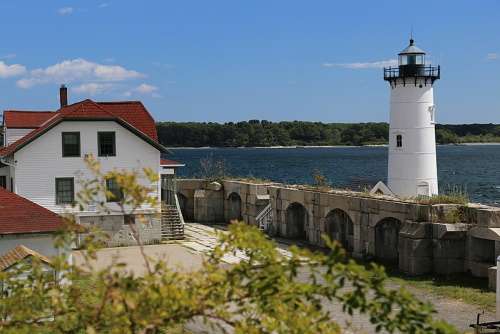
Fort Constitution and the Portsmouth Harbor Light.
An important skirmish before the war took place in New Castle, N.H. A handful of British soldiers manned Fort William and Mary there in 1774, when tensions rose between the colonies and England. The stone fort stood at the mouth of the Piscataqua River, guarding access to the harbor and to Kittery, Maine (then Massachusetts).
Paul Revere rode to Portsmouth in December to warn patriots that British troops might seize powder and guns at the fort. A raiding party of 400 men then stormed the fort. They subdued the six soldiers inside and took the gunpowder, muskets and cannon.
The fort, renamed Fort Constitution, now belongs to the State of New Hampshire. The Portsmouth Harbor Lighthouse stands inside the fort.
Fort Constitution Historic Site is a great spot for a picnic. For more information click here.
Quaker Hill, R.I.
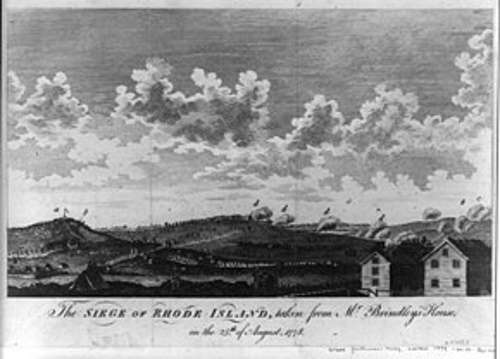
The most famous Rhode Island battle of the American Revolution is called the Battle of Rhode Island or the Battle of Quaker Hill. By August 1778, the British had occupied Newport, on Aquidneck Island, for almost two years. That month, Continental Army troops led by Gen. John Sullivan sailed from Tiverton to Portsmouth and set up a siege on Aquidneck. They planned to drive the British soldiers back to Newport and then recapture the town with the help of French naval forces.
But a hurricane prevented the French naval commander, Count d’Estaing, from attacking the 6,000 entrenched British soldiers. D’Estaing instead sailed his fleet to Boston for repairs. The patriots then tried to withdraw, but the British attacked them in Portsmouth in a valley among three hills. The Americans retreated to Tiverton without a single soldier killed. The 1st Rhode Island Regiment, comprised of African- and Native-American soldiers, took part in the action.
The 365 acres of the battlefield had no structures on them at the time of the conflict, but since then 36 houses and a barn have been built.
At the intersection of Route 2 and West Main, the state chapter of the NAACP put up a marker to commemorate the 1st Rhode Island’s role in the battle. And a granite memorial stone marks the Battle of Rhode Island on the corner of Union Street and Route 138 in Portsmouth.
A site of another skirmish is nearby. On the night of July 11, 1777, Col. William Barton and about three dozen infantrymen sailed from Tiverton to Middletown and captured British general Richard Prescott in his bed.
Prescott was occupying a farm owned by a Loyalist, despite warnings of inadequate security. That farm, now known as Prescott Farm, was restored with the help of heiress Doris Duke. The public can now visit. Visitors can tour the house where Barton captured Prescott, a windmill, a country store, a guardhouse and a historical vegetable garden. For more information, click here.
Hubbardton Battlefield, Vermont
The Hubbardton Battlefield in Hubbardton is the site of the only Revolutionary War battle fought entirely in Vermont (or what would become Vermont). (The Battle of Bennington was actually fought in New York state.) It’s also one of the best preserved battlefields in America.
The battle started on July 7, 1777, when British forces caught up with the American rear guard of the forces retreating after they withdrew from Fort Ticonderoga. The Americans, led by Seth Warner, fought with discipline and inflicted heavy casualties on the British. Though they lost the battle, they halted the British and prevented them from pursuing the main American army.
The battlefield itself and the small museum that explains it lie off the beaten path, but they feature stunning views of the Vermont landscape. It’s off Exit 5 on Route 4, between Rutland and New York state.
Click here for more information.
* * *
Coming soon from the New England Historical Society! Click here to order your copy.
Photos: Portsmouth Harbor Lighthouse and Fort Constitution By Kenneth Dupont – Own work, CC BY-SA 4.0, https://commons.wikimedia.org/w/index.php?curid=62728239. Fort Griswold Battlefield State Park by By Staxringold via English Wikipedia. Fort George earthworks and cannon by Jerrye and Roy Klotz via Wikipedia. Old North Bridge By Daderot at en.wikipedia, CC BY-SA 3.0, https://commons.wikimedia.org/w/index.php?curid=5942756. This story about Revolutionary War battlefields was updated in 2024.
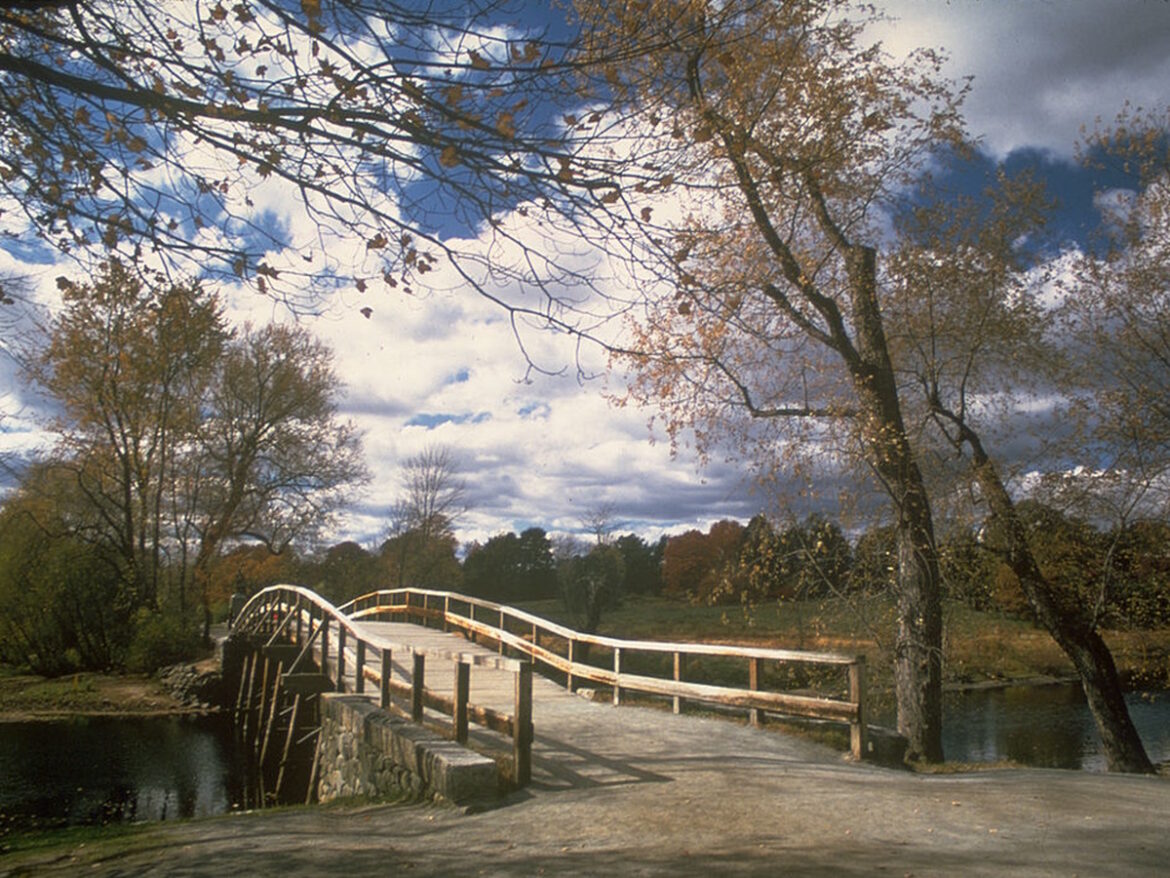


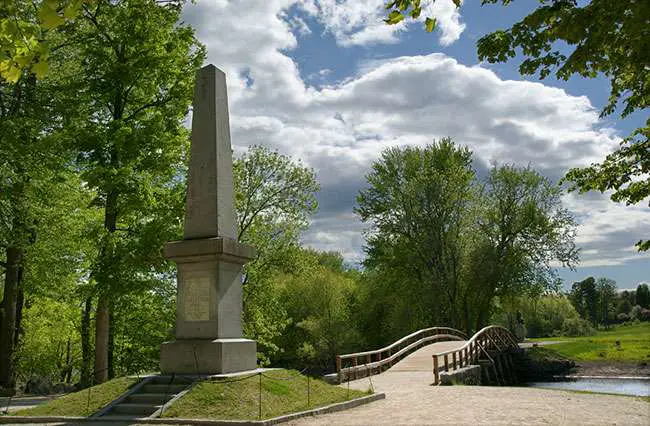
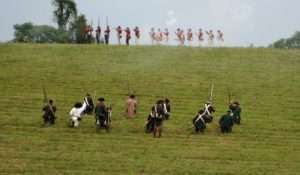
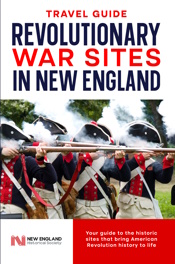

7 comments
[…] for Tories in the early days of the Revolution and housed British soldiers leading up to the Battle of Rhode Island. Among its more colorful owners was William Mayes Jr., a Rhode Island […]
[…] 1779, British warships and troop transports sailed into Bagaduce (now Castine, Maine), on the Penobscot Bay. Seven hundred British troops built a fort to defend Canada, deny […]
[…] The tough, disciplined members of Glover's Regiment had nautical skills that proved invaluable during the American Revolution. […]
The photo attributed to Fort Constitution is actually of Fort Stark. Please correct.
[…] and British troops stayed there during the occupation of Newport and the Battle of Rhode Island. It was used as a boarding house for many years until a benefactor donated money to the […]
[…] Elleanor Eldridge was an African-American woman born free in Rhode Island because her father fought in the American Revolution. […]
[…] is also home to Fort Griswold in Groton and Fort Trumbull in New […]
Comments are closed.